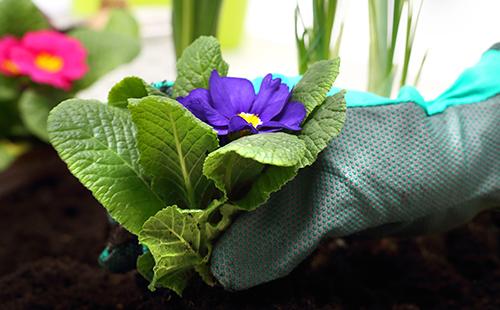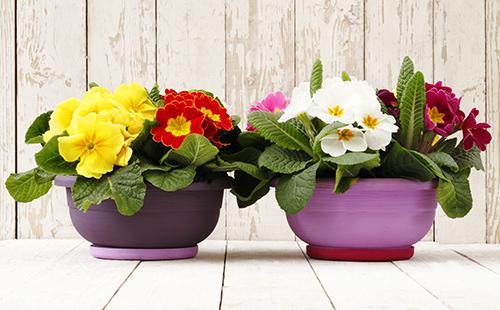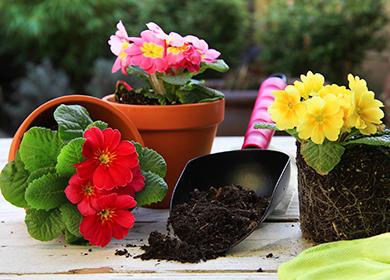The content of the article
From the Latin "primrose" is translated as "first" or "primrose". This name was not chosen by chance, the plant blooms one of the first. No wonder he is considered the herald of spring and presented to women on March 8. But in order to preserve this beauty on your windowsill, you need to familiarize yourself with some of the nuances.
Plant description
Primrose was the favorite flower of Catherine II. During the reign of the queen, the entire Winter Palace was fragrant with these flowers. The imperial services were ornamented with small primrose inflorescences. The British today create whole flower beds from them, use some types of leaves for vitamin salads and dry them in herbaria in memory of their loved ones.
Knowing how to care for primrose and in what conditions a delicate flower needs, you can easily create a real oasis of spring mood. And having planted a plant in open ground, you can equip a spectacular alpine hill.
Varieties
Most primroses are low herbaceous plants, which are most often perennials. Although there are annuals. Distinctive features of the plant:
- shortened stalk;
- fibrous rhizome;
- slightly pubescent leaves forming a basal rosette;
- flowers can be solitary or form paniculate, racemose inflorescence;
- all flowers have a contrasting yellow spot in the center.
About 500 species of primrose are known. In indoor floriculture, most often only three varieties are used, presented in the table.
Table - Types of indoor primrose
| Name | Characteristic | Features |
|---|---|---|
| Obconic primrose (inverse conic) | - Flower perennial; - can grow up to 20 cm; - the leaves have a rugged wavy edge, are elliptical in shape; - peduncles short, numerous; - wide whisk; - the flower can reach a diameter of 7 cm; - the flowers are lavender, blue, red, salmon, purple, pink | - Able to bloom year round; - often causes allergies |
| Soft leaved | - The plant reaches 30 cm in height; - the leaves are long, light green, characterized by a heart-shaped base and a slightly rugged edge; - many direct peduncles; - panicle inflorescences, in each panicle 15-20 flowers; - a whisk opened with a limb, about 4 cm in diameter; - color white, purple, blue, red, pink and even two-color terry | - Flowering begins in February-March and lasts 3-5 months |
| Stemless | - Compact perennial, height not more than 20 cm; - bright green long leaves with a pronounced central vein; - differs in a wrinkled surface; - single flowers (2-4 cm in diameter) bloom on thin peduncles; - most often pale yellow, but can be found in various shades and colors | - Flowers bloom in April; - blooms until July |
Caring for primrose: what to consider
The gentle primrose obkonika does not belong to the category of unpretentious plants. She needs to create special conditions in which she will be comfortable. Particular attention must be paid to lighting.
Seat selection
Heat-loving primrose loves light very much. She is happy to "bathe" in the sun. But the plant does not tolerate direct exposure. The bright sun leaves burns on the leaves, and delicate buds make it completely dry. A lover of light and the other extreme, the shadow, cannot stand it. Lack of light affects the plant even worse. Therefore, it is important to initially choose the right place for the green pet, in which there will be sufficient lighting. Florists recommend the following tricks.
- Eastern, western windows. They are considered the most optimal place for a roomy beauty.
- Special stand. If the house has only southern windows, then use a special stand by placing your beloved primrose near the window. And pay special attention to the plant in the summer, when the activity of the sun reaches its maximum peak.
- Shade or not shade. Some indoor flowers, which can not tolerate bright sunlight, feel comfortable on the southern windows, provided they are slightly shaded. This does not apply to primrose. The plant does not like such experiments. The slightest shading can adversely affect flowering.
Temperature mode
A gentle primrose loves heat, but is able to endure insignificant temperature drops. I strongly disagree with extreme heat. If you want to enjoy beautiful flowering, then provide primrose such conditions.
- In the spring. Starting in March, and even possible in February, provide the plant with a temperature in the range + 16 ° С ... + 21 ° С. At this time, the vegetative period begins, so the culture needs heat. Having created a normal mode, you will see that in the spring, from March to April, primrose blooms in a pot.
- Summer. If you provide the flower with normal temperature conditions and sufficient lighting, then primrose obconica can bloom all year round. In summer, your pet can be taken out onto the street or to the balcony, choosing a place protected from the wind and direct sun.
- In winter. With the onset of cold weather, flower growers recommend lowering the temperature slightly. Primrose comfortably winters at + 16 ° С ... + 18 ° С. Drops below + 15 ° C may simply not be tolerated.
Humidity
In wildlife, primrose blooms just during the snowmelt. It provides high moisture culture. At home, this situation cannot be recreated. But to take all measures to increase humidity is simply necessary. The flowering period begins in the spring, at the end of the heating season, when the batteries still create excessively dry air. There are several ways to achieve the required humidity.
- Apply pallet. Take a large pan, pour gravel and fill it with water. Put a primrose on top. Constant evaporation will provide the necessary humidity. Just do not forget to add water to the pan.
- Put capacity. This is the easiest method to save all green pets, lovers of a humid climate. You just need to place water containers on the windowsill.
- Spraying plants. Periodically, it is necessary to irrigate the flower with settled water. It is important not to fall on delicate inflorescences.
- Install a humidifier. This technique will independently humidify the air.
Watering
Tender primrose makes special demands on watering. Water scarcity or its excess can lead to the completion of flowering, and sometimes to the death of the culture.Therefore, always monitor the condition of the soil. It should be slightly moist and loose. Even slight drying out of the soil can completely destroy the plant. Florists recommend watering the primrose, taking into account the following two recommendations.
- Soft water. The favorite will be grateful for the standing water, a little warm. Suitable to melt water or rainwater. Watering primrose tap is strictly prohibited.
- Irrigation intensity. During the growing season, watering should be moderate. When the flowers bloom on the primrose, you can moisten the soil a little more intensively. After flowering, gradually reduce watering. But at the same time, do not allow the soil to dry out even during wintering.
Top dressing
Beauty primrose needs moderate top dressing. Sometimes it is recommended not to fertilize the plant at all until it begins to bloom. Otherwise, culture will put all its strength into the greenery, and completely forget about the need to create beautiful inflorescences. Experienced experts recommend not depriving the flower of dressings, but carefully selecting fertilizers. Provide primrose simple conditions for each season.
- In the spring. Before the flowering period, you can add a solution of calcium nitrate. For 10 liters of water - a tablespoon. Such top dressing will provide leaf growth and saturate the culture with nitrogen and calcium. It is recommended to make it no more than once a month.
- Flowering period. When the primrose blooms, it is recommended to feed it with fertilizer for flowering crops. You can use ready-made potash-phosphorus fertilizer, for 10 liters of water - a tablespoon. Such fertilizers are applied every two to three weeks.
- Fall. After flowering, in the late autumn, add a handful of fresh compost to the pot.

Transfer
The young plant needs annual transplants. This procedure is carried out in the fall, approximately in October. This will provide abundant flowering for next year. Mature culture can be transplanted once every two to three years. The transplant is carried out taking into account the following recommendations.
- Pot selection. Primrose loves wide and shallow flowerpots. Choose a not very large pot for transplanting. It should in diameter exceed the old one by only 1-1.5 cm.
- Soil preparation. Get primrose soil mix for geraniums. Add sand to it, taking three quarters of the soil and one part of the sand.
- Drainage. Be sure to put pebbles or broken ceramics at the bottom of the pot.
- Transfer. The primrose is carefully transplanted. It is best to do transshipment so as not to damage the root system. The socket should not go deep into the soil. She always remains on the surface.
2 ways of reproduction
It is not difficult to propagate the beauty primrose. Even a beginner grower will cope with such a procedure. There are two breeding methods. Choose the one that is more to your liking.
Seeds
Features. Growing primrose from seeds at home is a simple event, but troublesome and will require patience. Start planning your seed planting in July. Planting material can be collected independently after flowering or purchased at a flower shop.
Action algorithm
- It is necessary to take fertile soil and combine it with the same amount of sand. Moisten the mixture well.
- Sow the seeds on the ground. They should not be deepened. Sprinkle the top carefully with soil.
- The container can be covered with polyethylene or glass.
- Transfer the container with seedlings to a cool place with a temperature of + 16 ° С ... + 18 ° С. Do not forget to moderately moisten the soil.
- After two to three weeks, the first shoots will appear. After 1.5 months, they are rooted so much that they can be planted in different pots.

Dividing the bush
Features. You can propagate the primrose by dividing the bush. This procedure is carried out during a plant transplant. This allows you to not only change the pot, but also get two, and sometimes three, beautiful flowers. If seed planting begins in July-August, then it is recommended to plant the primrose after dividing the rhizome in October. Although you can begin to multiply the plant immediately after flowering.
Action algorithm
- During transplantation, gently shake the ground, cleaning the root system.
- Young processes separate from the rhizome. In addition, each new plant must have a growth point.
- Transplant the mother primrose into a container selected in advance.
- Plant young plants in wet sand and cover with polyethylene.
- Germinate young primrose in a cool and darkened place, not forgetting to periodically ventilate them and water the soil.
- After two to three weeks, the plants take root.
- You can plant flowers in separate flowerpots after the appearance of rosettes.
If something is wrong: diseases and pests
Beauty primrose requires special care and does not forgive serious errors in care. Incorrect lighting, temperature spikes, excess or lack of water, inappropriate humidity - the plant will respond to all these factors with a disease. Therefore, if a spring guest appeared in the house, then provide her with decent care, and having noticed the first signs of the disease, immediately begin treatment, focusing on the table.
Table - Primrose problems and methods for solving them
| Problem Description | Cause | Troubleshooting Methods |
|---|---|---|
| The leaves of the primrose began to turn yellow | - Long-term waterlogging of the soil; - dry air; - the temperature is high in the room; - too frequent or voluminous top dressing; - use of hard water | - Normalize watering; - choose the right water for irrigation; - moisten the air; - transfer the flower to another room or provide a cool temperature; - review fertilizer application frequency |
| Flower drops buds | - Watering deficit; - dry air; - heat in the room | - Normalize the conditions of detention |
| Leaves become soft, watery, a gray coating appears | - Excessive humidity or watering; - sharp differences between heat and dampness | - Reduce humidity; - allow the soil to dry out a little; - cut the leaves affected by the disease; - treat with chemicals “Fitosporin-M”, “Skor”, “Sternifag”, “Fundazol”, “Euparen”, “Topaz”, “Chistotsvet” |
| The leaves turn pale, gradually begin to turn yellow and dry; thin web is visible | - Spider mite | - Cut off all leaves affected by the pest; - reduce the temperature in the room and increase the humidity; - in case of a mild lesion, treat with a soapy solution; - if it is strong, use the Lightning, Fitoferm, Zolon, Akarin, Kungfu, Fufanon, Aktelik, Antiklesch drugs |
| Buds, leaves curl, turn yellow, sometimes an adhesive surface is noticeable | - Aphids | - Wash single pest lesions with soapy water; - with a strong spread of aphids, use the preparations “Komandor”, “Anitlin”, “Fitoferm”, “Actelik”, “Decis”, “Tobacco dust”, “Spark” |
Providing care for primrose during flowering, remember one more small trick. All dried inflorescences must be removed immediately. They should not remain on the plant. This will extend the flowering period of the spring beauty.
Florist reviews
I prolong the life of primrose by the usual division. I have several varieties and varieties of Chinese (medium peduncles and dissected leaves), reverse conic (high peduncles) and garden - stemless. After flowering, the primrose forms several rosettes, and so I separate and plant and they perfectly inherit the maternal qualities and wonderfully bloom.Indoor primrose is better not to plant, bend. You can plant only garden forms. Even primroses are perfectly propagated by seeds, but previously cold stratification is required.
Irishka, https://forum.bestflowers.ru/t/primula-primula-uxod-v-domashnix-uslovijax.1047/
Primrose usually cannot live in an apartment with more than one bloom. Especially if purchased in the fall or winter. At temperatures above + 18 ° C, the leaves turn yellow, brown, dry or rot. It does not tolerate waterlogging of soil and salinization (high concentration of fertilizers). Plant after flowering is better to plant in the country. Primrose needs a bright window and coolness. If there are 2-3 leaves, it will probably reach the spring.
Andrew, https://www.greeninfo.ru/indoor_plants/primula html / Forum / - / tID / 2738
Sowed the seeds of primrose on January 5. Sowed superficially and under the greenhouse. The jar of crops was removed in a dark and cool place. Today (January 18) I noticed that the seeds hatch. She placed the jar with seeds on a rack closer to the light. 01.21 Today I became convinced that the primrose in the dark sprouts very well. I planted two cups with primrose seeds, put one cup in the dark and the other on a backlit rack. And then a bowl of darkness pleased me with seeds hatching in it. I decided to remove the second bowl as well, because in the light the seeds lay on the surface of the ground and did not think to hatch. And on the third day, I noticed that the seeds began to hatch. I will try to grow primrose from seeds.
Fun, https://flowrum.ru/threads/primula-vyraschivanie-iz-semyan.935/page-3
The primrose blossomed (grew it from seeds) last year. This is the third flowering of the year. True, the flowers should be flowers in the form of roses (on the bag photo). But I like it. It grows by itself. He stands on the windowsill, in my apartment it’s cool, the batteries in the wall. If you dry the soil, it will immediately wither. In the summer in the shade on an open balcony. That's all.
Chamomile, http://forum-flower.ru/showthread.php?t=457&page=8

